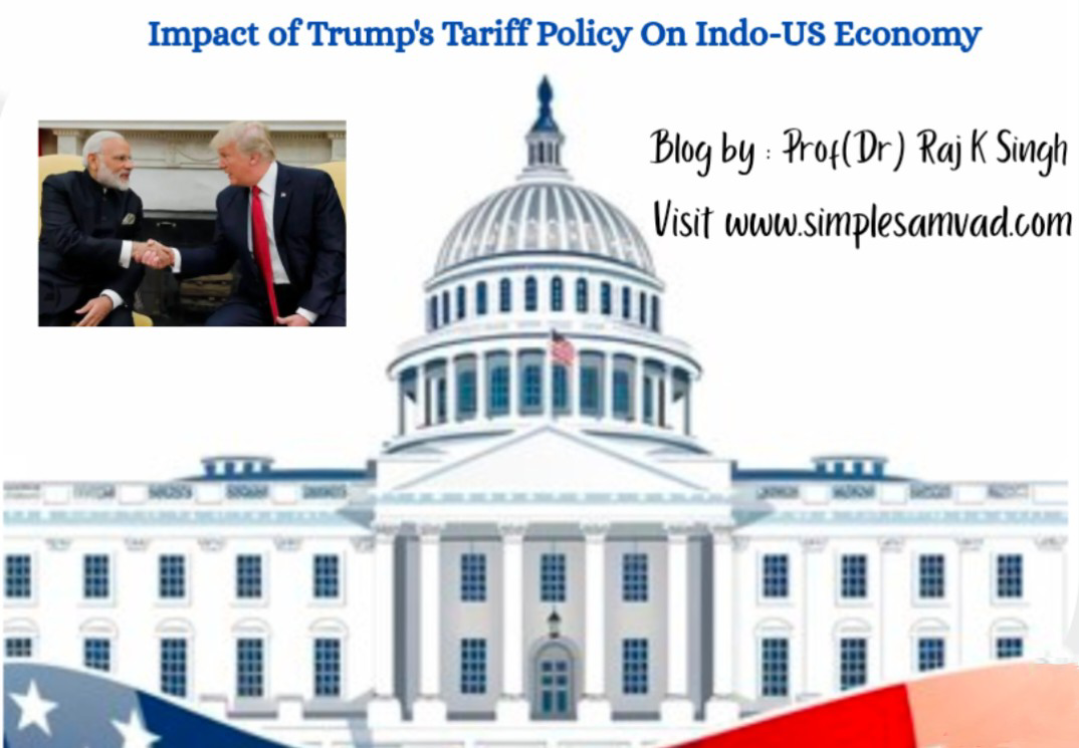Prof (Dr) Raj K. Singh
When Donald Trump took oath as 47th US President of US and promised to ‘Make America Great Again’ (MAGA). It was an obvious promise since he has earlier declared as US is facing the ‘Crisis of Trust’ and he has pledged to restore the sovereignty, safety and justice in USA. Now if we categorically analyze the above words declared by the US President Trump, we must realize that these were not the simple words told in a formal manner. Actually these words signifies the concern , mindset and political-economic philosophy of US president and common aware American. For the entire world US has always created an international perception that America is a ‘Great Country’ politically, economically, socially, culturally, militarily, technologically and strategically. This is true also to a large extent. Then what happened with America so that the President Trump has to promise to ‘MAGA’. To understand this we need to analyze the last 10 years Geo-Political and Economic condition of the entire world. The emerging economy of China and India along with few other economies has created a position of economic dilemma before the policy makers of US. Now in this world the war is basically more economic and less military.
The US Economist and few prominent industrialists like Elon Musk has influenced President Trump that other countries take the benefit of America’s relatively liberal trade and tariff policy and put high tariff on the American products to benefit their economy. This situation is continuously weakening the open US economy with the low average tariff rates and economy of other countries are now getting stronger and stronger taking advantage of this. Trump has committed their US Voters in the Presidential Election that he will put a new tariff regime based on ‘Reciprocal Tariffs’. A Reciprocal Tariff is a tax or trade restriction that one country places on another in response to the similar actions taken by that country. The idea behind reciprocal tariffs is to create balance in trade between nations. The objective of President Donald Trump is to promote the indigenous manufacturing of US and to promote other countries to come to US and do manufacturing as of China or India. Ideologically this seems to be logical and correct also. However is the economic ecosystem of US and its International approach allow this so smoothly is a matter of critical examination.
On March 4, 2025, the US President Donald Trump, in his address to the US Congress, has stated that global trading partners of US have long imposed higher tariffs on US goods than the US imposed tariff on imports from other countries, which in his opinion is creating an imbalance in international trade and US is economically suffering from that. He has announced the reciprocal tariffs on trade partners countries like India, China, and the European Union (EU) starting April 2, 2025, regardless of their economic status. The real havoc is experienced when President Trump has imposed a 25% additional tariff on imports from Canada and Mexico and a 10% additional tariff on imports from China. Apart from this the border problem of US due to the illegal intruders are one of the major economic and security threat for the USA. Although due to the good relationship between Indian Prime Minster Mr Narendra Modi and US President Donald Trump this was an obvious prediction that the Indo- US relationship will get improved better than the earlier regime of Former US President of America Joe Biden whose policies were majorly unfavorable so far as the interest of India was concerned . Although this is a fact that America already see its interest on first priority and this is very natural. India’s only concern is that the Trump’s Tariff policy should not impact adversely the trade dynamics of India and India’s Economic condition.
The new US Tariff Policy expected to impact India’s key industrial sectors such as automobiles, semiconductors, and pharmaceuticals, which may face tariffs as high as 25 percent. This will adversely impact the Indian Trade. In the influence of industrialists like Elon Musk , Senior Advisor to the President of the United States, the US President Trump criticized India’s high import duties, particularly in the automobile sector, where tariffs exceed 100 percent. We need to understand that Elon Musk is trying to sell the Tesla in Indian Market by getting it manufactured in China. Whereas the Indian government is insisting that Tesla should be manufactured in India under the ‘Make in India’ programme of Government of India so that the Original Equipment Manufacturer (EOM) which are basically lying in the MSME sector of India should get benefitted by making the assembled parts of Car and create more job opportunities . Since taking office, the US President Donald Trump has announced a series of actions on various types of products the US trades with India like:
Agricultural Products: Tariffs on imported agricultural goods will be imposed from April 2, 2025.
Lumber: Tariff on timber and lumber imports is to be implemented by November 2025.
Steel and Aluminum: Tariffs to be rising from 10 percent to 25 percent
Automobiles: 25 percent tariff on auto imports will be from April 2, 2025.
Copper: Tariff on Copper imports is to be implemented by November 2025.
Semiconductors: Tariffs of 25 percent or higher is expected to be introduced.
Pharmaceuticals: Tariffs of 25 percent or higher is expected to be introduced.
As per the information from the Department of Commerce, Ministry of Commerce and Industry, Government of India following the situation of Indo-US Trade Relations which clearly indicates our economic interdependence :
- India’s export to US in 2023-2024 was 77,515.03 (US$ Million)
- India’s import from US in 2023-2024 was 42,195.49 (US$ Million)
- The growth percent of India’s import from US is – 17.04%
- The total trade between India and US is 119,710.52 (US$ Million)
- The total growth percent of trade between India and US is – 07.49%
- Major Commodities exported from India to the US are Electrical machinery and equipment and parts thereof; sound recorders and reproducers; television image and sound recorders and reproducers , Natural or cultured pearls, precious or semiprecious stones, pre-metals, clad with pre-metal and artifacts thereof; imitation jewelry; coin, Pharmaceutical products, Mineral fuels, mineral oils, and products of their distillation; bituminous substances; mineral waxes, Articles of iron or steel, Other made-up textile articles; sets; worn clothing and worn textile articles; rags ,Vehicles other than railway or tramway rolling stock, and parts and accessories thereof. Articles of apparel and clothing accessories, not knitted or crocheted and Organic chemicals.
- Major Commodities imported from US to India are Mineral fuels, mineral oils, and products of their distillation; bituminous substances; mineral waxes, Natural or cultured pearls, precious or semiprecious stones, pre. metals, clad with pre. metals and articles thereof; imitation jewelry; coin. Nuclear reactors, boilers, machinery, and mechanical appliances; parts thereof. Electrical machinery and equipment and parts thereof; sound recorders and reproducers; television image and sound recorders and reproducers; and parts. Optical, photographic, cinematographic measuring, checking precision, medical, or surgical instruments, and apparatus parts and accessories thereof, Ships, boats, and floating structures, Organic chemicals, Miscellaneous chemical products, Edible fruit and nuts; peel or citrus fruit or melons.
India and the US Comparative Tariff
As per a study by the Indian Council for Research on International
Economic Relations (ICRIER) India imposes an average tariff of 17% on
US whereas Tariff imposed by the US on India is as lower as 3.3%. Significently in agriculture export to US, the India’s simple average tariff on US is 39 %, compared to 5% in the US export of Agricultural Produce to India.
On the basis of the above study the effect of Trump’s Tariff on India will be
- There will be a higher costs for Indian exporters to the US market
- Possibility of decline in trade volume from India to US
- There will be an adverse Impact on US consumers due to high cost of Indian Goods
- Potential countermeasures may be taken by the Indian government which may retaliate by imposing duties on US imports
- A new Trade Negotiation between India and US will be needed
New Trade Strategy for India in the changing circumstances :
India is having a geographical and natural advantage in the field of Agriculture and other natural products where only India is having their trade dominance. So imposing Tariff on these products are in the hand of India. Now entire Global Market for India is open due to the International Quality, spreading of Indian Diaspora all around the world and increasing political acceptance and International Relations of India . India should explore the export possibilities with the countries in Europe , Latin America, Southeast Asia and Africa since in these countries the India will have its Tariff advantages. Indo American joint ventures in US will also help to some extent in facing such tariff issues. India may also restructure flexible negotiable pricing strategy in order to retain the US business.
The pharmaceutical and IT sector where India heavily rely on US exports may face decline in demand which needs to be compensated through the other developing and underdeveloped countries of the world. The US Consumers is going to be sufferer due to the high cost of the Indian products. Looking to the changing situation the Indian government should seriously focus on their Make in India mission to make India a Manufacturing hub and give India a better manufacturing alternate to the world in comparison to China and America. A better ecosystem for the developing of the Ease of Doing of Business in India needs to be developed based upon our own economic policy and potential lookin to the global demand. The Strategic Policymaking, diversification of export market and proactive diplomatic consideration will be the need of hour. Indo-Us bilateral trade is the base of our diplomatic relations so both side .India can neither solely depend on US nor it can leave Indo- US trade relations. This should be the base line for any future of action from both side of US and India economic policy.
Prof (Dr) Raj K. Singh
(Author Is An International Expert of Geo-Economic Affairs)



International Relations
Excellent
Good.
Knowledgeable good work sir